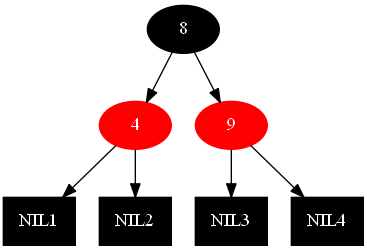Java的一些组件很有趣,希望大家多深入研究研究!
A. 核心要点:
-
类继承
public class TreeMap<K,V>
extends AbstractMap<K,V>
implements NavigableMap<K,V>, Cloneable, Serializable -
一个有序的key-value集合,基于红黑树(Red-Black tree)实现。该映射根据其键的自然排序进行排序,或者根据创建映射时提供的 Comparator 进行排序,具体取决于使用的构造方法。
-
此实现为 containsKey、get、put 和 remove 操作提供受保证的 log(n) 时间开销。这些算法是 Cormen、Leiserson 和 Rivest 的 Introduction to Algorithms 中的算法的改编。
-
此实现不是线程同步的。如果多个线程同时访问一个映射,并且其中至少一个线程从结构上修改了该映射(添加或者删除一个或多个映射),则其必须 外部同步。需要SortedMap m = Collections.synchronizedSortedMap(new TreeMap(…)); 来保证同步。
-
和其他Collections一样,iterator 方法返回的迭代器都是快速失败 的:在迭代器创建之后,如果从结构上对映射进行修改,除非通过迭代器自身的 remove 方法,否则在其他任何时间以任何方式进行修改都将导致迭代器抛出 ConcurrentModificationException。
B. 红黑树介绍
Treemap是基于红黑树实现的,其实红黑树的应用很是广泛。主要是用它来存储有序的数据,它的时间复杂度是O(lgn),效率高。
Java集合中的TreeSet和TreeMap,C++ STL中的set、map,以及Linux虚拟内存的管理,都是通过红黑树去实现的
什么是红黑树?
红黑树是每个节点都带有颜色属性的二叉查找树,颜色或红色或黑色。在二叉查找树强制一般要求以外,对于任何有效的红黑树我们增加了如下的额外要求:
性质1. 节点是红色或黑色。
性质2. 根节点是黑色。
性质3 每个叶节点(NIL节点,空节点)是黑色的。
性质4 每个红色节点的两个子节点都是黑色。(从每个叶子到根的所有路径上不能有两个连续的红色节点)
性质5. 从任一节点到其每个叶子的所有路径都包含相同数目的黑色节点。
这些约束强制了红黑树的关键性质: 从根到叶子的最长的可能路径不多于最短的可能路径的两倍长。结果是这个树大致上是平衡的。因为操作比如插入、删除和查找某个值的最坏情况时间都要求与树的高度成比例,这个在高度上的理论上限允许红黑树在最坏情况下都是高效的,而不同于普通的二叉查找树。
红黑树举例:
C. Treemap部分源码分析。
对于一个map来说,插入,删除是经典动作,下面我们看一下Treemap的插入,删除源码。
- 插入, 下面以注释的方法来讲解
//put 就是往红黑树里面添加节点
public V put(K key, V value) {
Entry<K,V> t = root;
//如果红黑树为空,则插入根节点
if (t == null) {
compare(key, key); // type (and possibly null) check
root = new Entry<>(key, value, null);
size = 1;
modCount++;
return null;
}
int cmp;
Entry<K,V> parent;
// split comparator and comparable paths
// 下面这段代码是找到当前key-value,插入红黑树中的位置,treemap是以key为顺序的,所以按照key来比较。
Comparator<? super K> cpr = comparator;
if (cpr != null) {
do {
parent = t;
cmp = cpr.compare(key, t.key);
if (cmp < 0)
t = t.left;
else if (cmp > 0)
t = t.right;
else
return t.setValue(value);
} while (t != null);
}
else {
if (key == null)
throw new NullPointerException();
Comparable<? super K> k = (Comparable<? super K>) key;
do {
parent = t;
cmp = k.compareTo(t.key);
if (cmp < 0)
t = t.left;
else if (cmp > 0)
t = t.right;
else
return t.setValue(value);
} while (t != null);
}
//此处,新建红黑树节点,key,value是待插入的值
Entry<K,V> e = new Entry<>(key, value, parent);
if (cmp < 0)
parent.left = e;
else
parent.right = e;
//添加完节点以后,就可能不是一棵红黑树了,需要修正。
fixAfterInsertion(e);
size++;
modCount++;
return null;
}
/** From CLR */
//修正,保证插入完之后,还是一棵红黑树
private void fixAfterInsertion(Entry<K,V> x) {
x.color = RED;
while (x != null && x != root && x.parent.color == RED) {
if (parentOf(x) == leftOf(parentOf(parentOf(x)))) {
Entry<K,V> y = rightOf(parentOf(parentOf(x)));
if (colorOf(y) == RED) {
setColor(parentOf(x), BLACK);
setColor(y, BLACK);
setColor(parentOf(parentOf(x)), RED);
x = parentOf(parentOf(x));
} else {
if (x == rightOf(parentOf(x))) {
x = parentOf(x);
rotateLeft(x);
}
setColor(parentOf(x), BLACK);
setColor(parentOf(parentOf(x)), RED);
rotateRight(parentOf(parentOf(x)));
}
} else {
Entry<K,V> y = leftOf(parentOf(parentOf(x)));
if (colorOf(y) == RED) {
setColor(parentOf(x), BLACK);
setColor(y, BLACK);
setColor(parentOf(parentOf(x)), RED);
x = parentOf(parentOf(x));
} else {
if (x == leftOf(parentOf(x))) {
x = parentOf(x);
rotateRight(x);
}
setColor(parentOf(x), BLACK);
setColor(parentOf(parentOf(x)), RED);
rotateLeft(parentOf(parentOf(x)));
}
}
}
root.color = BLACK;
}
- 删除, 下面以注释的方法来讲解
/**
* Delete node p, and then rebalance the tree.
*/
private void deleteEntry(Entry<K,V> p) {
modCount++;
size--;
// If strictly internal, copy successor's element to p and then make p
// point to successor.
if (p.left != null && p.right != null) {
Entry<K,V> s = successor(p);
p.key = s.key;
p.value = s.value;
p = s;
} // p has 2 children
// Start fixup at replacement node, if it exists.
Entry<K,V> replacement = (p.left != null ? p.left : p.right);
if (replacement != null) {
// Link replacement to parent
replacement.parent = p.parent;
if (p.parent == null)
root = replacement;
else if (p == p.parent.left)
p.parent.left = replacement;
else
p.parent.right = replacement;
// Null out links so they are OK to use by fixAfterDeletion.
p.left = p.right = p.parent = null;
// Fix replacement
if (p.color == BLACK)
fixAfterDeletion(replacement);
} else if (p.parent == null) { // return if we are the only node.
root = null;
} else { // No children. Use self as phantom replacement and unlink.
if (p.color == BLACK)
fixAfterDeletion(p);
if (p.parent != null) {
if (p == p.parent.left)
p.parent.left = null;
else if (p == p.parent.right)
p.parent.right = null;
p.parent = null;
}
}
}
共同学习,写下你的评论
评论加载中...
作者其他优质文章





